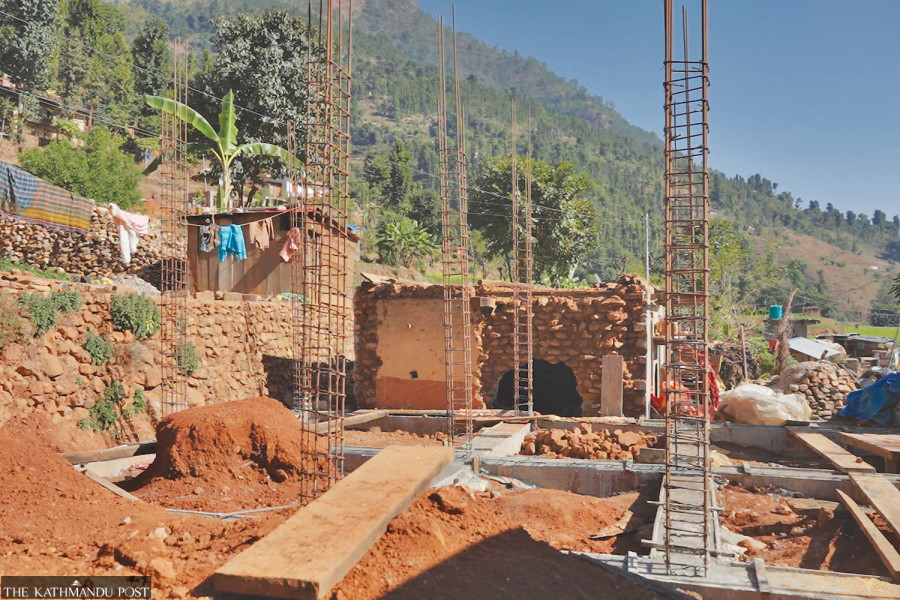National
Frustrated by delays, Rukum West quake survivors ignore building codes
Facing harsh winter and with no aid, many survivors are rebuilding on their own with minimal resources.
Mahesh KC
Chandra Oli of Golchaur in ward 4 of Sanibheri Rural Municipality built a new house a year after a 6.4 magnitude earthquake destroyed his old house on November 3 last year. He used iron rods, cement and stones for the construction and believes his concrete house is strong enough to withstand future earthquakes. However, he is unaware about the building code that should be strictly followed to make the house truly earthquake-resistant.
“I think the new house is earthquake-resistant as it is built with iron rebars and cement,” said Oli. Like him, almost all villagers in Rukum West are unaware of the building codes. Many mistakenly believe houses with reinforced concrete pillars are quake-resistant.
The 6.4 magnitude earthquake on November 3, 2023 struck Jajarkot, Rukum West and Salyan, causing huge loss of life and property. Around 8,000 public structures including schools, offices and health posts were damaged, and at least 157 died in Jajarkot and Rukum West districts. According to Karnali Provincial Police in Surkhet, over 50,000 houses were destroyed in the three districts. Jajarkot was the epicenter.
Rebuilt houses and other structures in the affected areas should ideally be quake-resistant. But most earthquake victims here are unaware about the building codes and are constructing houses without following the rules. Such houses may be vulnerable to future earthquakes, according to technicians and experts.
The National Building Code prepared by the federal government has set specific standards for constructing houses for different locations based on local seismic data. The Local Government Operation Act-2017 has granted local governments the authority to issue permits to build houses in compliance with the code and to regulate and monitor whether the code is being implemented.
Local units have set standards for building houses and other structures. However, these standards have not been fully implemented in the quake-hit districts of Karnali Province.
Earthquake victims want to bypass the building code as they have to go through a lengthy approval process for house designs and they deem the costs of meeting the standards high.
“We are building a new house on our own as we have to spend much time and money to get the design approved by the local unit. Getting an approval from the rural municipality will cost us around Rs40,000-Rs 50,000. So we are building our new house as per the contractor’s advice,” said Dibya Pun, an earthquake victim from ward 4 of Sanibheri. “We are building a one-storey concrete house with a bank loan.” Pun, however, said that she does not know whether her new house would be able to withstand a sizable quake.
Even 14 months after the disaster, the federal government is yet to prepare guidelines for the permanent housing of earthquake victims. According to the Temporary Housing Construction Grant Procedures for Earthquake Affected Households-2023, the government provides a total of Rs50,000 in two tranches to each displaced family whose houses were completely or partially damaged and rendered uninhabitable.
However, many victims are yet to get the second tranche of Rs25,000. So, they took out loans to build temporary shelters, but these huts cannot shield them from the cold.
Thousands of quake-displaced people still languish in temporary huts. Many families have returned to their damaged houses despite the risks, as the flimsy huts do not provide adequate protection from the harsh winter. And some people have started building houses of their own initiative by ignoring the building code.
Local units admit their failure in implementing the building standards while the earthquake victims press ahead with reconstruction.
“A total of 151 new houses have been built in various wards of Sanibheri Rural Municipality, but very few have followed the building code. The federal government has yet to come up with a housing reconstruction plan. Victims are building houses on their own. How can we enforce the building code in such a situation?” said Birkha Bahadur Bista, chairman of Sanibheri Rural Municipality.
Temperatures started plummeting in the earthquake hit districts from December second week. Many quake displaced people have been shivering in the poorly-built tin-roof huts. They vented their ire at the government for not helping them \build permanent houses.
“The government provided only Rs50,000 to erect temporary shelters. We expected more help to build permanent houses. People living in huts are falling ill from the cold. How are we supposed to survive?” said Maisar Jaisi of ward 14 of Athabiskot Municipality.




 31.12°C Kathmandu
31.12°C Kathmandu












